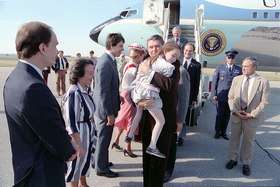Katie Beckett Medicaid waiver
A Katie Beckett waiver or TEFRA waiver is a Medicaid waiver concerning the income eligibility for home-based Medicaid services for children under the age of nineteen. Prior to the Katie Beckett waiver, if a child with significant medical needs received treatment at home, all of the financial resources of the parents would be "deemed" as the income of the child for the purposes of determining Medicaid eligibility. Only after a hospitalization lasting more than thirty days would the parents' income no longer be deemed to the child, allowing the child to then qualify for Medicaid coverage. The effect was that many families, unable to afford home treatment, kept their children in costly hospital settings in order to meet the Medicaid 30-day requirement. Katie Beckett waivers allow Medicaid to cover medical services for children in the home, regardless of the parents' income, in cases where home-based treatment will cost less than or the same as treatment in a hospital.[1]

The waiver is named for Katie Beckett, a three-year-old who had been hospitalized since infancy so that she could receive ventilator assistance after a viral encephalitis infection left her partially paralyzed in a way that affected her ability to breathe.[2] When her situation came to the attention of the newly elected Reagan administration, then preparing its first budget, the administration seized the story as a way to deregulate and reduce the costs of Medicaid.
The waiver is also called a TEFRA waiver because it was passed as a provision of the Tax Equity and Fiscal Responsibility Act of 1982. After the age of nineteen, people with disabilities can transition to Medicaid Home and Home and Community-Based Services Waivers.
Background and enactment
Mary Katherine Beckett was born 9 March 1978 in St. Luke's Hospital, Cedar Rapids, Iowa, to parents Julie and Mark Beckett. At four months, she contracted viral encephalitis. The brain inflammation put her in a coma and left her partially paralyzed in a way that affected her ability to breathe and with grand mal seizures. Her difficulty breathing required her to be on a ventilator most hours of the day.
Subsequent developments
Katie Beckett died in the same hospital in which she was born at the age of 34 on 18 May 2012, three times the age her physicians forecast she would reach.[2]
See also
- Least restrictive environment
- Medicaid waiver
- Medicaid Home and Home and Community-Based Services Waivers
- Olmstead v. L.C.
References
- Smith & Moore 2015, p. 151.
- Hevesi, Dennis (May 22, 2012). "Katie Beckett, Who Inspired Health Reform, Dies at 34". The New York Times. Retrieved January 6, 2019.
Bibliography
- Musumeci, Mary Beth (March 2011). "Modernizing Medicaid Eligibility Criteria for Children with Significant Disabilities: Moving from a Disabling to an Enabling Paradigm". American Journal of Law and Medicine. 37 (1): 81–127. doi:10.1177/009885881103700103.
- Semansky, Rafael M.; Koyanagi, Chris (July 2004). "The TEFRA Medicaid Eligibility Option for Children with Severe Disabilities: A National Study". The Journal of Behavioral Health Services and Research. 31 (3): 334–342. doi:10.1007/BF02287295.
- Smith, David G.; Moore, Judith D. (2015). Medicaid Politics and Policy (Second ed.). New Brunswick, N.J.: Transaction Publishers. ISBN 978-1-4128-5674-4.